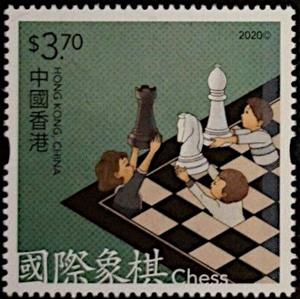Stamp: Chess (Hong Kong 2020)
Chess (Hong Kong 2020)
21 April (Hong Kong ) within release Children's Games - Board Games (2020) goes into circulation Stamp Chess face value 3.70 Hong Kong dollar
| Stamp Chess in catalogues | |
|---|---|
| Stamp Number: | Sn: HK 2076 |
| Yvert et Tellier: | Yt: HK 2144 |
| WADP Numbering System - WNS: | WAD: HK022.20 |
Stamp is square format.
Also in the issue Children's Games - Board Games (2020):
- Stamp - Chinese Chess face value 2;
- Stamp - Jungle face value 2.60;
- Stamp - Aeroplane Chess Game face value 3.40;
- Stamp - Chess face value 3.70;
- Stamp - Chinese Checkers face value 4.90;
- Souvenir Sheet - Children's Games - Board Games face value 21.60;
- Stamp - Go face value 5;
Stamp Chess it reflects the thematic directions:
Chess is usually played by two players (called chess players) against each other. It is also possible for one group of chess players to play against another or against one player; such games are often called consultation games. In addition, there is the practice of simultaneous play sessions, when several opponents play against one strong player, each on a separate board.
The rules of the game were basically developed by the 15th century; In modern official tournaments, the rules of the International Chess Federation[6] are applied, which regulate not only the movement of pieces, but also the rights of the judge, the rules of behavior of players and time control. A game played remotely - for example, by correspondence, by telephone or via the Internet - has special rules. There are many variants of chess that differ from classical ones: with non-standard rules, pieces, board sizes, etc. The corresponding section of chess composition is fairy chess. Some aspects of the game of chess are studied in mathematics (for example, the classic “Knight's Move Problem” and “Eight Queens Problem”), including through computer simulation. Chess is usually played by two players (called chess players) against each other. It is also possible for one group of chess players to play against another or against one player; such games are often called consultation games. In addition, there is the practice of simultaneous play sessions, when several opponents play against one strong player, each on a separate board.
The rules of the game were basically developed by the 15th century; In modern official tournaments, the rules of the International Chess Federation[6] are applied, which regulate not only the movement of pieces, but also the rights of the judge, the rules of behavior of players and time control. A game played remotely - for example, by correspondence, by telephone or via the Internet - has special rules. There are many variants of chess that differ from classical ones: with non-standard rules, pieces, board sizes, etc. The corresponding section of chess composition is fairy chess. Some aspects of the game of chess are studied in mathematics (for example, the classic “Knight's Move Problem” and “Eight Queens Problem”), including through computer simulation.
Play is a range of intrinsically motivated activities done for recreational pleasure and enjoyment. Play is commonly associated with children and juvenile-level activities, but may be engaged in at any life stage, and among other higher-functioning animals as well, most notably mammals and birds.


